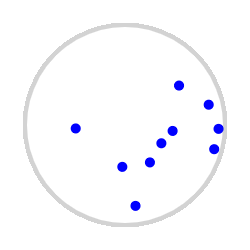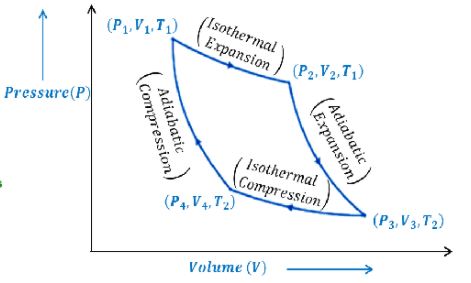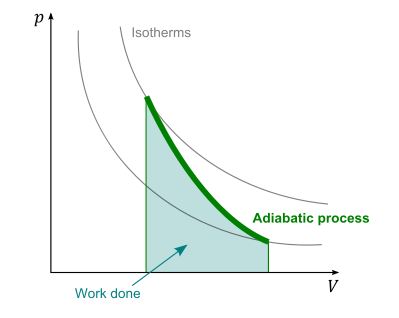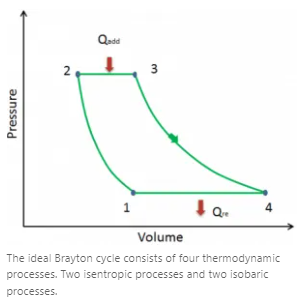Adiabatic compression is a thermodynamic process, where the internal energy of the system increases due to rise in temperature.
Adiabatic compression is characterized by nil transfer of heat between the system and surroundings. The increase in temperature during the adiabatic compression leads to increase pressure which is normally observed to be much steeper than rate of volume decrease.
An adiabatic process can be defined by the expression:
PVꝩ = Constant
Where,
P= System Pressure
V: System Volume
ꝩ = Ratio of specific heat of gas (Cp/Cv)
Here Cp is the specific heat at Constant pressure conditions and Cv is the specific heat at Constant volume conditions. In the above equation, it is considered that the system is insulated perfectly from the surroundings such that dQ=0, or no heat transfer is taking with the surroundings. The other assumption of the above expressions is that the gas must be an ideal gas (compressibility factor =1)
In practical operation, ideal behaviour is shown by few gases or composition of gases. Moreover, there is always heat loss to the surroundings when a PV work is carried out by a system. However, for all practical purposes most gases shows close to ideal behaviour at pressure and temperature above their boiling point. Under these conditions, the collisions between the gases are perfectly elastic and the intermolecular forces between the colliding atoms are almost non-existent.

Image|: elastic collision
Source: https://www.nuclear-power.com/nuclear-engineering/thermodynamics/ideal-gas-law/what-is-ideal-gas/
Another practical example of adiabatic process is gas turbine operation, where the change process is very raid. In these processes, the heat loss does occur but the amount is quite low compared to the heat transferred in the process making it insignificant. Another example of an adiabatic process is compression and the expansion strokes of an internal combustion engine.

PV diagram of strokes in an IC engine
Image Source: https://engineeringinsider.org/adiabatic-process-types/
What is Adiabatic Compression?
In thermodynamics, an adiabatic process is characterized by dQ=0, where Q is the heart transferred with the surrounding.
Adiabatic compression is a process, where there the PV work done is negative and it results in increase temperature of system. This rise in temperature increases the internal energy of the system.
Adiabatic compression assumes perfect insulation, which is purely theoretical. Adiabatic assumption can however be safely made by engineers for all practical purposes in processes which are fairly well insulated or which are very rapid.
Adiabatic Compression how it works?
The adiabatic compression works on the same principles in as that of first law of thermodynamics.
The first law of thermodynamics state that
dQ= dU + dW
In adiabatic compression, since the heat transfer with surroundings is nil, the above equation can be written as:
dU= -PdV
The above implies the increase in internal energy corresponds to decrease in volume. The increase in internal energy is indicated by rise in temperature of the system.

PV Diagram of an adiabatic process
Source: https://engineeringinsider.org/adiabatic-process-types/
Is Compression always Adiabatic?
Compression is carried out for compressible fluids, which is basically gas and it occurs through different thermodynamic routes.
Gas compression process can be three types thermodynamically: – Isothermal, adiabatic and polytropic compression. All these different types of compressions can lead to different terminal conditions for same amount of work done.
Isothermal compression: As the name suggest, this type of compression occurs at constant temperature. This is achieved by providing jacketed coolant over the compressor body and or providing inter-stage cooling. In practical applications however, complete isothermal compression is very difficult to achieve. A close to isothermal compression can be achieved by allowing the compression process to undergo at a very slow pace with sufficient time provided to remove the heat generated in the process. Isothermal compression is given by the expression
PV= constant
Adiabatic Compression: This type of compression requires the compression to be carried out with no loss or gain of heat from the surrounding. A perfectly insulated system is required to achieve the same. Another method to achieve adiabatic compression is to carry out the compression at a very rapid pace, so that no time is provided for transfer of heat from the system to the surrounding. The adiabatic compression is given by the expression:
PVꝩ= constant, where ꝩ is the ratio of specific heats of the gas being compressed.
Polytropic compression: Polytropic compression defines the actual compression processes taking place in real life compression systems such as those in a gas compressor. A polytropic compression process is given by expression:
PVn = Constant, where n varies from 1-1.4
Adiabatic Compression Formula
Adiabatic compression formula is derived from the first law of thermodynamics considering there is no transfer heat to and from the system.
The formula for adiabatic compression can be expressed in various forms i.e. in PV form, in TV form and as PT form, where P, V and T are pressure, volume and temperature respectively.
The adiabatic compression in Pressure and Temperature form is given by:
P1-Ꝩ Tꝩ = Constant
The adiabatic compression in Volume and temperature form:
TVꝩ-1= Constant
The adiabatic compression in Pressure and volume form is given by:
PVꝩ= Constant
How to calculate Adiabatic Compression?
The adiabatic compression can be calculated by using the formula PVꝩ= Constant.
A piston compressing a gas in a cylinder will be called an adiabatic process, when the heat transfer to the surrounding is nil. In such case, if the initial conditions (P1 and V1) along with the ratio of specific heat of gas (ꝩ) are known, either of the final conditions (P2, V2) can be obtained if one is specified. Thus, the formula becomes:
P1V1ꝩ= P2V2ꝩ
What causes adiabatic compression (irrelevant)
Work done in Adiabatic Compression
The work done in an adiabatic process can be derived from the formula for adiabatic process
PVꝩ= Constant (K). This formula can be rewritten as P=KV-ꝩ
In order to calculate the work done in adiabatic process , let us consider the system is compressed from the initial position of P1, V1 and T1 to final position P2, V2 and T2. The work done is given by
Work done (W)= Force x displacement
W= Fdx
W=PAdx
W=P(Adx)
W=PdV
In order to calculate work done during compressing from V1 to V2, PdV is required to be integrated with limits of V1 and V2
Or W=
Or W=dV Where P=KV-ꝩ
This can be given as the work done in an adiabatic process.
Integrating further, we get the final expression for work done as
W=1/(1−γ) {P2V2−P1V1}
What is the work done in adiabatic process
An adiabatic process can either be adiabatic compression or an adiabatic expansion.
In case of adiabatic compression, work is done by the surrounding on the system and in adiabatic expansion work is done by the system on the surrounding. Work done in adiabatic process is same as work done in adiabatic compression or expansion.
An example of adiabatic expansion is rising of hot air in the atmosphere, which adiabatically expands due to lower atmospheric pressure and cools down as a result. In this case work is done by the rising hot air and work is done by the system.
Is work negative in Adiabatic Compression?
Yes, work done by the system during adiabatic compression is negative.
Adiabatic compression takes place with an increase in internal energy of the system. We know from first law of thermodynamics that since dQ in adiabatic compression is nil,
dU + dW=0
or dU=-dW
dU and dW shares a negative relation with each other. Thus, since the internal energy change is positive the work done is negative.
The relation can also be corroborated by the fact that, during adiabatic compression as the internal energy rises, the work is done by the surrounding on the system and hence work done by system on surrounding is negative.
On the contrary, work done by system on the surrounding during adiabatic expansion is positive.
How do you calculate work done in Adiabatic Process?
An adiabatic process is can be achieved if the expansion or compression of gas is carried in a perfectly insulated system or is carried out so fast that heat transfer to surroundings is negligible.
Mathematically, there is no difference between an adiabatic expansion and adiabatic compression and hence they follow the same formulas and derivations.
Thus, all the formulas utilized for adiabatic compression noted above holds true for any adiabatic process.
Is Adiabatic Compression reversible?
Adiabatic compression is reversible if there is no change in entropy
A process is called reversible if it is isentropic or there is no change in entropy of the system or dS=0. An adiabatic compression is the one where there is no change in the heat transfer with the surroundings. For an adiabatic compression to be reversible, the compression process must be frictionless.
An example of a reversible adiabatic compression which is also called an isentropic compression can be found in in a gas turbine or modern jet engines. This gas turbines follow the Brayton cycle as shown below.

In the above figure, The ideal Brayton cycle consists of four thermodynamic processes.
Stage 1-> stage 2: Isoentropic compression
Stage 2-> stage 3: Isobaric heating
Stage 3-> stage 4: Iso entropic Expansion

I am Sangeeta Das. I have completed my Masters in Mechanical Engineering with specialization in I.C Engine and Automobiles. I have around ten years of experience encompassing industry and academia. My area of interest includes I.C. Engines, Aerodynamics and Fluid Mechanics. You can reach me at